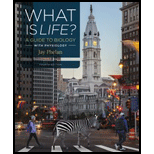
Concept explainers
To review:
What CRISPR is and how it is used to edit genes.
Introduction:
CRISPR stands for “clustered regularly interspersed short palindromic repeats”, referring to the way DNA was originally organized in some viruses.
Explanation of Solution
Bacteria regularly incorporate bits of viral DNA into their own circular DNA. This way, when a viral particle infects them and injects its DNA, the bacteria produce RNA strands that are complementary to the viral DNA, which will bind to the viral DNA. The bacteria then use the enzyme Cas9 to cut the DNA bound by the RNA strands into fragments.
Taking inspiration from this immune mechanism of bacteria -
- The CRISPR technology makes use of a synthetic RNA guide molecule which can bind to the target DNA in a cell.
- The Cas9 enzyme (guided by the RNA molecule) is used to cut the DNA that has been bound by the RNA.
- A new gene can be inserted into this position to alter the cell in as needed.
- A plasmid carrying the DNA for the synthesis of the RNA guide and the Cas9 enzyme can be inserted into target cell for the whole process to occur.
This technology results in more precise editing of the gene.
CRISPR stands for “clustered regularly interspersed short palindromic repeats”, which refers to a type of DNA organization in viruses. This technique takes inspiration from this immune mechanism of bacteria, where the bacterial cell uses an RNA molecule to guide enzymes to cut invading DNA molecules.
Want to see more full solutions like this?
Chapter 7 Solutions
What Is Life? A Guide to Biology with Physiology
- how Inverse PCR identifies genes withtransposon insertions?arrow_forwardWhat is the main reason for using a cDNA library rather than a genomic library to isolate a human gene from which you wish to make large quantities of the human protein in bacteria? How will you identify clones of interest?arrow_forwardWhat are the possible bioethical issues that gene editing tools may encounter?arrow_forward
- What is the function of the CRISPR/Cas system? What are the ethical impacts of a technology such as CRISPR?arrow_forwardWhat is the difference between the first steps of DNA sequencing to PCR in terms of thenumber of primers being used?arrow_forwardWhat is southern blot? Understand PCR reaction in detail. What polymerase enzyme is used in PCR reaction?arrow_forward
 Human Anatomy & Physiology (11th Edition)BiologyISBN:9780134580999Author:Elaine N. Marieb, Katja N. HoehnPublisher:PEARSON
Human Anatomy & Physiology (11th Edition)BiologyISBN:9780134580999Author:Elaine N. Marieb, Katja N. HoehnPublisher:PEARSON Biology 2eBiologyISBN:9781947172517Author:Matthew Douglas, Jung Choi, Mary Ann ClarkPublisher:OpenStax
Biology 2eBiologyISBN:9781947172517Author:Matthew Douglas, Jung Choi, Mary Ann ClarkPublisher:OpenStax Anatomy & PhysiologyBiologyISBN:9781259398629Author:McKinley, Michael P., O'loughlin, Valerie Dean, Bidle, Theresa StouterPublisher:Mcgraw Hill Education,
Anatomy & PhysiologyBiologyISBN:9781259398629Author:McKinley, Michael P., O'loughlin, Valerie Dean, Bidle, Theresa StouterPublisher:Mcgraw Hill Education, Molecular Biology of the Cell (Sixth Edition)BiologyISBN:9780815344322Author:Bruce Alberts, Alexander D. Johnson, Julian Lewis, David Morgan, Martin Raff, Keith Roberts, Peter WalterPublisher:W. W. Norton & Company
Molecular Biology of the Cell (Sixth Edition)BiologyISBN:9780815344322Author:Bruce Alberts, Alexander D. Johnson, Julian Lewis, David Morgan, Martin Raff, Keith Roberts, Peter WalterPublisher:W. W. Norton & Company Laboratory Manual For Human Anatomy & PhysiologyBiologyISBN:9781260159363Author:Martin, Terry R., Prentice-craver, CynthiaPublisher:McGraw-Hill Publishing Co.
Laboratory Manual For Human Anatomy & PhysiologyBiologyISBN:9781260159363Author:Martin, Terry R., Prentice-craver, CynthiaPublisher:McGraw-Hill Publishing Co. Inquiry Into Life (16th Edition)BiologyISBN:9781260231700Author:Sylvia S. Mader, Michael WindelspechtPublisher:McGraw Hill Education
Inquiry Into Life (16th Edition)BiologyISBN:9781260231700Author:Sylvia S. Mader, Michael WindelspechtPublisher:McGraw Hill Education





